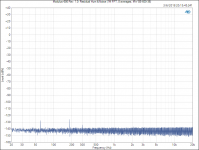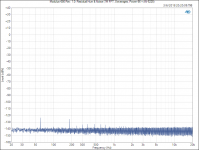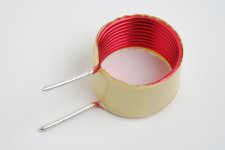Well, yeah. You'll probably crush the shoulder washer before you even get close to 100 psi. If you read data sheets for the various thermal interface products, you'll notice that they're often spec'ed at 10,25,50,100 psi. I suspect Wakefield just published the 100 psi number as it is the lowest thermal impedance.
Tom
Tom
I was always wondering, solid state caps seem to have more leakage current than traditional types, and electrolytics have some asymmetric behavior as well, these do not show up in measurements?
Speaking of measurements: Here's a pair of residual hum/noise measurements. One with the SMPS. The other with the Power-86 and Antek AN-5225 transformer.
The integrated noise measures 31.5 uV (unweighted); 25.0 uV (A-weighted).
Tom
The integrated noise measures 31.5 uV (unweighted); 25.0 uV (A-weighted).
Tom
Attachments
Documentation
Yes please start writing! 😉
In the meantime, are the inductors the same size / number of turns as those used in the Para 86?
Yes please start writing! 😉
In the meantime, are the inductors the same size / number of turns as those used in the Para 86?
Yep. I'm way behind (i.e. not started) on documentation. Thankfully, the documentation will mostly be a spec table, a ton of warnings about heat sinking and such, and some pictures showing connector pinouts. I'll add a block level circuit description and description of the error correction as well. So the good news there is that we're talking maybe ten pages of writing plus a few appendices.
The inductors are the same as those used in the LM3886DR and Modulus-286. I had a bunch professionally wound and am selling them on my website. You'll need two of these per Modulus-686 board. I'll provide instructions for how to make the inductors for those who'd rather make their own.
In future designs (think Modulus-286 Rev. 2.0) I'll use this standard inductor.
Tom
The inductors are the same as those used in the LM3886DR and Modulus-286. I had a bunch professionally wound and am selling them on my website. You'll need two of these per Modulus-686 board. I'll provide instructions for how to make the inductors for those who'd rather make their own.
In future designs (think Modulus-286 Rev. 2.0) I'll use this standard inductor.
Tom
Attachments
Speaking of measurements: Here's a pair of residual hum/noise measurements. One with the SMPS. The other with the Power-86 and Antek AN-5225 transformer.
The integrated noise measures 31.5 uV (unweighted); 25.0 uV (A-weighted).
Excuse me, Tom, these are only the PSU measurements or the Modulus powered with two differnt PSUs?
Excuse me, Tom, these are only the PSU measurements or the Modulus powered with two differnt PSUs?
The noise measurements in Post #245 shows the residual noise and hum of the Modulus-686 when powered by the Mean Well SE-600-36 and Power-86 + Antek AN-5225, respectively.
Tom
-125 dBV (~500 nV) isn't quiet enough for you? Many amps, in particular tube amps, have approaching 1 mV of mains hum.
BTW: I tried those Wakefield phase change pads I mentioned in Post #239. They work pretty well. They turn out to be phase change goop on a polymer carrier, so basically a modern equivalent of a mica washer + goop.
The worst case power dissipation is at Pout_max/2, so I picked 100 W into 8 Ω as my test point. With the Bergquist K10 pads, I measured 83-85 ºC on the front of the chip package with a 60 ºC heat sink temperature. Repeating this test with the Wakefield phase change pads results in a chip temperature of around 80-82 ºC. The difference is not earth shaking but given that the Wakefield pads are half the cost of the Bergquist K10, you might as well get the Wakefield.
The phase change pads do have the drawback that they're one time use only. So if you ever need to remove the LM3886es from the heat sink, you will have to replace the thermal pads.
Tom
BTW: I tried those Wakefield phase change pads I mentioned in Post #239. They work pretty well. They turn out to be phase change goop on a polymer carrier, so basically a modern equivalent of a mica washer + goop.
The worst case power dissipation is at Pout_max/2, so I picked 100 W into 8 Ω as my test point. With the Bergquist K10 pads, I measured 83-85 ºC on the front of the chip package with a 60 ºC heat sink temperature. Repeating this test with the Wakefield phase change pads results in a chip temperature of around 80-82 ºC. The difference is not earth shaking but given that the Wakefield pads are half the cost of the Bergquist K10, you might as well get the Wakefield.
The phase change pads do have the drawback that they're one time use only. So if you ever need to remove the LM3886es from the heat sink, you will have to replace the thermal pads.
Tom
THD+N and IMD measurements.
The THD+N plots mostly show the THD+N floor of the APx525 signal source. The IMD plots are more interesting.
Siegfried Linkwitz speculates based on the Fletcher-Munson curves that a 1 kHz + 5.5 kHz IMD correlates well with the perceived listening experience. He performs this measurement at 100 mW and 1 W. The closest I could get with the AP was 917 Hz (5500/6 Hz) + 5.5 kHz. The Modulus-686 is about 20 dB better than the best amp shown on SL's website.
The 18+19 kHz and SMPTE show no surprises. Just rock star performance.
The multi-tone IMD residual of -110 dBV is rather spectacular as well.
For fun I ran the 100 Hz, 1 kHz, 6.66 kHz THD+N vs Power sweeps (20 kHz BW). You often see these measurements for Class D amplifiers, so I figured I'd showcase the fact that the MOD686 is about two orders of magnitude lower THD+N than many Class D amps (specifically, I compared with the ICE Power 1200AS module).
Tom
The THD+N plots mostly show the THD+N floor of the APx525 signal source. The IMD plots are more interesting.
Siegfried Linkwitz speculates based on the Fletcher-Munson curves that a 1 kHz + 5.5 kHz IMD correlates well with the perceived listening experience. He performs this measurement at 100 mW and 1 W. The closest I could get with the AP was 917 Hz (5500/6 Hz) + 5.5 kHz. The Modulus-686 is about 20 dB better than the best amp shown on SL's website.
The 18+19 kHz and SMPTE show no surprises. Just rock star performance.
The multi-tone IMD residual of -110 dBV is rather spectacular as well.
For fun I ran the 100 Hz, 1 kHz, 6.66 kHz THD+N vs Power sweeps (20 kHz BW). You often see these measurements for Class D amplifiers, so I figured I'd showcase the fact that the MOD686 is about two orders of magnitude lower THD+N than many Class D amps (specifically, I compared with the ICE Power 1200AS module).
Tom
Attachments
-
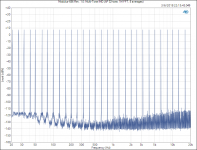 Modulus-686 Rev. 1.0_ Multi-Tone IMD (AP 32-tone, 1M FFT, 8 averages).png63.7 KB · Views: 244
Modulus-686 Rev. 1.0_ Multi-Tone IMD (AP 32-tone, 1M FFT, 8 averages).png63.7 KB · Views: 244 -
 Modulus-686 Rev. 1.0_ IMD - DFD 18 kHz + 19 kHz @ 1_1 (100 W, 8 ohm).PNG34.5 KB · Views: 217
Modulus-686 Rev. 1.0_ IMD - DFD 18 kHz + 19 kHz @ 1_1 (100 W, 8 ohm).PNG34.5 KB · Views: 217 -
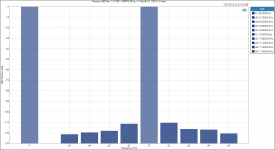 Modulus-686 Rev. 1.0_ IMD - SMPTE 60 Hz + 7 kHz @ 4_1 (100 W, 8 ohm).PNG40.1 KB · Views: 195
Modulus-686 Rev. 1.0_ IMD - SMPTE 60 Hz + 7 kHz @ 4_1 (100 W, 8 ohm).PNG40.1 KB · Views: 195 -
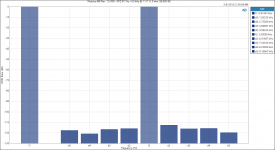 Modulus-686 Rev. 1.0_ IMD - DFD 917 Hz + 5.5 kHz @ 1_1 (1 W, 8 ohm, SE-600-36).PNG40.6 KB · Views: 199
Modulus-686 Rev. 1.0_ IMD - DFD 917 Hz + 5.5 kHz @ 1_1 (1 W, 8 ohm, SE-600-36).PNG40.6 KB · Views: 199 -
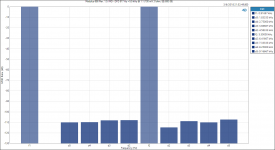 Modulus-686 Rev. 1.0_ IMD - DFD 917 Hz + 5.5 kHz @ 1_1 (100 mW, 8 ohm, SE-600-36).png41.3 KB · Views: 243
Modulus-686 Rev. 1.0_ IMD - DFD 917 Hz + 5.5 kHz @ 1_1 (100 mW, 8 ohm, SE-600-36).png41.3 KB · Views: 243 -
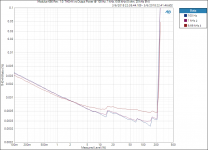 Modulus-686 Rev. 1.0_ THD+N vs Output Power @ 100 Hz, 1 kHz, 6.66 kHz (8 ohm, 20 kHz BW).PNG48.4 KB · Views: 676
Modulus-686 Rev. 1.0_ THD+N vs Output Power @ 100 Hz, 1 kHz, 6.66 kHz (8 ohm, 20 kHz BW).PNG48.4 KB · Views: 676 -
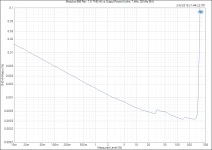 Modulus-686 Rev. 1.0_ THD+N vs Output Power (4 ohm, 1 kHz, 20 kHz BW).PNG53 KB · Views: 688
Modulus-686 Rev. 1.0_ THD+N vs Output Power (4 ohm, 1 kHz, 20 kHz BW).PNG53 KB · Views: 688 -
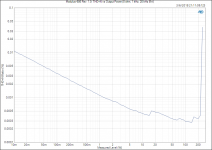 Modulus-686 Rev. 1.0_ THD+N vs Output Power (8 ohm, 1 kHz, 20 kHz BW).png48.5 KB · Views: 669
Modulus-686 Rev. 1.0_ THD+N vs Output Power (8 ohm, 1 kHz, 20 kHz BW).png48.5 KB · Views: 669 -
 Modulus-686 Rev. 1.0_ THD+N vs Frequency (200 W, 4 ohm, 60 kHz BW).PNG34.4 KB · Views: 676
Modulus-686 Rev. 1.0_ THD+N vs Frequency (200 W, 4 ohm, 60 kHz BW).PNG34.4 KB · Views: 676 -
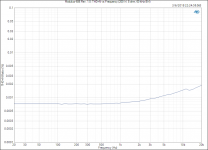 Modulus-686 Rev. 1.0_ THD+N vs Frequency (200 W, 8 ohm, 60 kHz BW).PNG34.7 KB · Views: 697
Modulus-686 Rev. 1.0_ THD+N vs Frequency (200 W, 8 ohm, 60 kHz BW).PNG34.7 KB · Views: 697
Last edited:
Hi Tom
Did you remove the technical info for the 286 from your webpage? I know you discontinued the current version, but these infos were a valuable source of infos for us 286 owners and also useful to compare to the new 686. It also helps when I would sell my two mono 286 in order to upgrade to 686.
Could you bring the info back please. Just but a big sticker discontinued on the website.
Thanks I really appreciate it.
SH
Ps. My bad sorry. I found it. It had just moved from the products to the support section.
Did you remove the technical info for the 286 from your webpage? I know you discontinued the current version, but these infos were a valuable source of infos for us 286 owners and also useful to compare to the new 686. It also helps when I would sell my two mono 286 in order to upgrade to 686.
Could you bring the info back please. Just but a big sticker discontinued on the website.
Thanks I really appreciate it.
SH
Ps. My bad sorry. I found it. It had just moved from the products to the support section.
Last edited:
More measurements.
The gain flatness comes in at ±0.039 dB (20 Hz - 20 kHz).
The drop in CMRR at LF is from the input coupling caps. The CMRR is quite high across the board, so I'm not concerned.
Tom
The gain flatness comes in at ±0.039 dB (20 Hz - 20 kHz).
The drop in CMRR at LF is from the input coupling caps. The CMRR is quite high across the board, so I'm not concerned.
Tom
Attachments
-
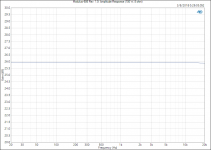 Modulus-686 Rev. 1.0_ Amplitude Response (100 W, 8 ohm).png34.5 KB · Views: 222
Modulus-686 Rev. 1.0_ Amplitude Response (100 W, 8 ohm).png34.5 KB · Views: 222 -
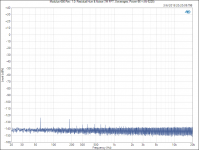 Modulus-686 Rev. 1.0_ Residual Hum & Noise (1M FFT, 8 averages, Power-86 + AN-5225).PNG49.6 KB · Views: 212
Modulus-686 Rev. 1.0_ Residual Hum & Noise (1M FFT, 8 averages, Power-86 + AN-5225).PNG49.6 KB · Views: 212 -
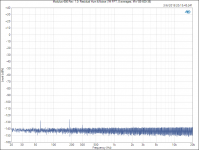 Modulus-686 Rev. 1.0_ Residual Hum & Noise (1M FFT, 8 averages, MW SE-600-36).png49.2 KB · Views: 214
Modulus-686 Rev. 1.0_ Residual Hum & Noise (1M FFT, 8 averages, MW SE-600-36).png49.2 KB · Views: 214 -
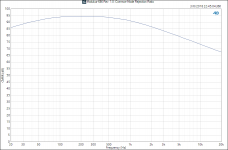 Modulus-686 Rev. 1.0_ Common-Mode Rejection Ratio .png26 KB · Views: 207
Modulus-686 Rev. 1.0_ Common-Mode Rejection Ratio .png26 KB · Views: 207 -
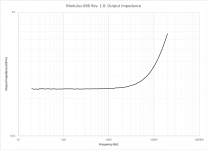 MOD686_R1p0_OutputImpedance.png61.3 KB · Views: 207
MOD686_R1p0_OutputImpedance.png61.3 KB · Views: 207 -
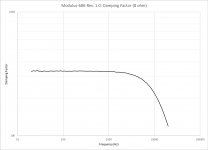 MOD686_R1p0_DampingFactor.png58.1 KB · Views: 252
MOD686_R1p0_DampingFactor.png58.1 KB · Views: 252 -
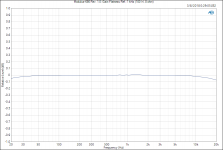 Modulus-686 Rev. 1.0_ Gain Flatness Ref._ 1 kHz (100 W, 8 ohm).PNG32.9 KB · Views: 192
Modulus-686 Rev. 1.0_ Gain Flatness Ref._ 1 kHz (100 W, 8 ohm).PNG32.9 KB · Views: 192
Did you remove the technical info for the 286 from your webpage?
No. Good to hear you found it in the Support section: Neurochrome :: Modulus-286
Tom
-125 dBV (~500 nV) isn't quiet enough for you?
No 🙁
It's very good, but I remember a 12uV figure in the preliminary specs.
Can you do something to improve it?
Documentation
Suggestion: confirmation of how to wire up the 2 Meanwells per channel would be good to include.
Suggestion: confirmation of how to wire up the 2 Meanwells per channel would be good to include.
More measurements.
I checked them all now; everything looks excellent.
The noise is just "good" 😉 Looks like mains hum (60hz in Canada i guess, we have 50hz in Europe) and I'm sure something can be done about it in the PSU rather than touching the amp.
It's very good, but I remember a 12uV figure in the preliminary specs.
Can you do something to improve it?
Yep. Switch to 20 dB gain. That drops the noise to the 16 uV (A-weighted), 20 uV (unweighted) that you recall.
If that's not low enough for you, I suggest designing a system cooled with liquid nitrogen. It'll be a bit of a mess to operate, but the noise will be low. 🙂
Tom
- Home
- Vendor's Bazaar
- Modulus-686: 380W (4Ω); 220W (8Ω) Balanced Composite Power Amp with extremely low THD

